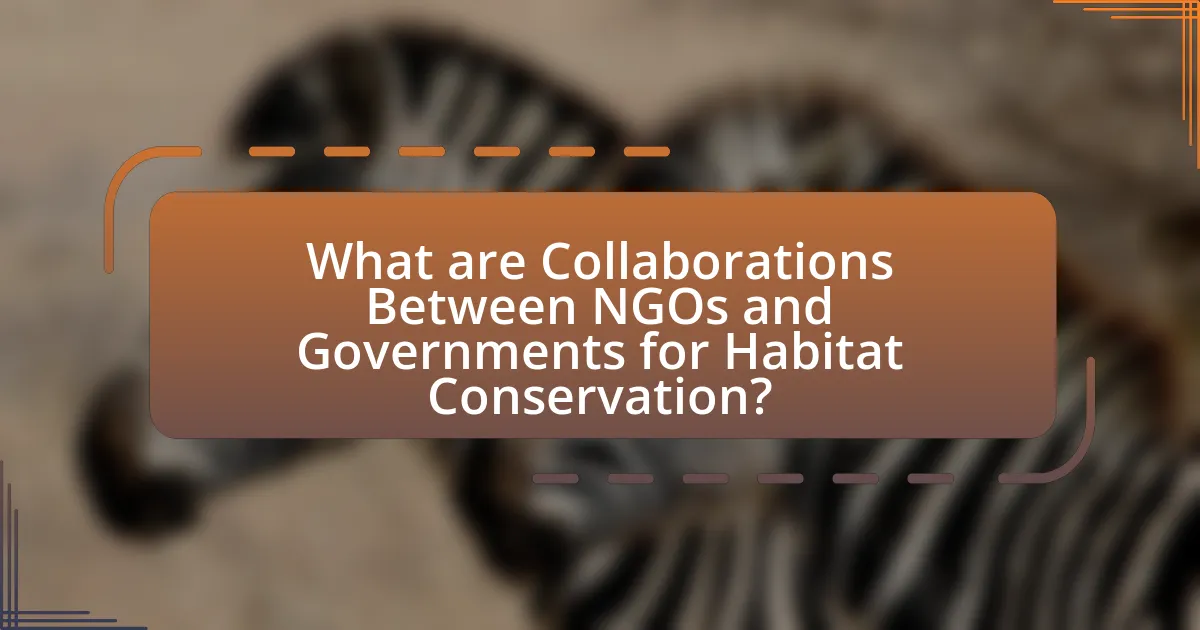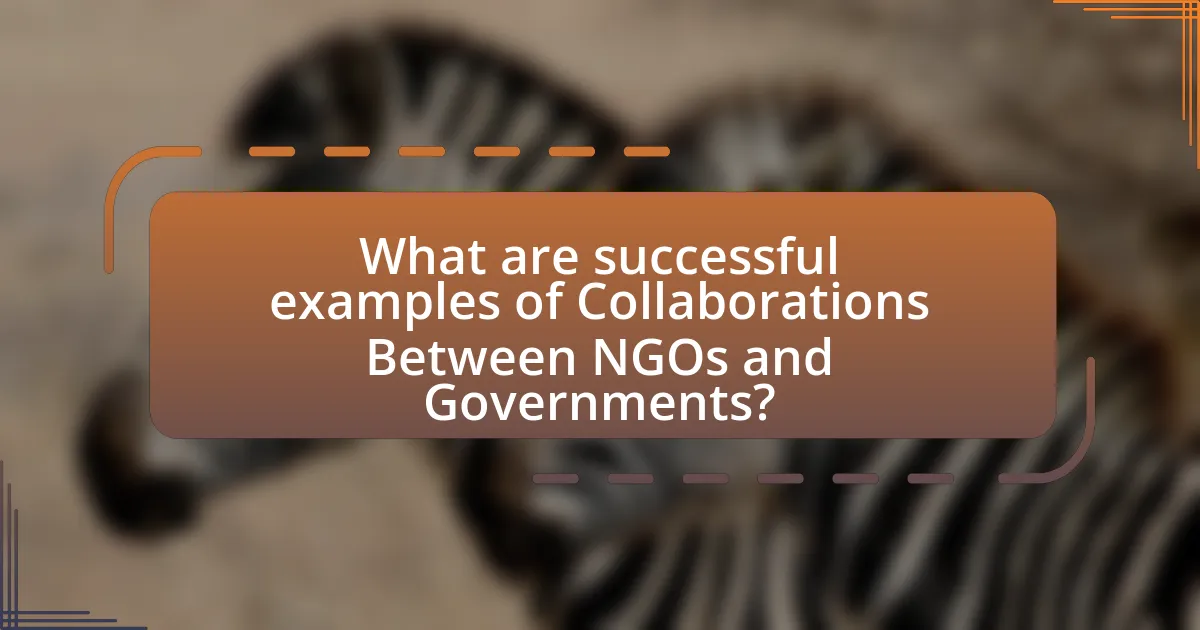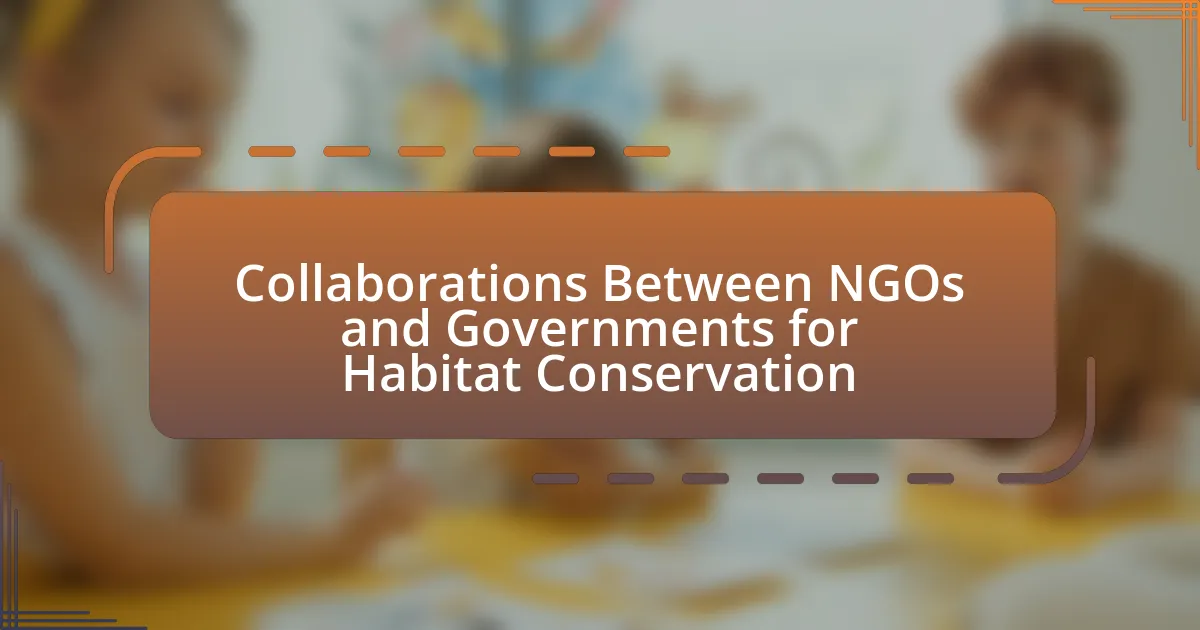Collaborations between non-governmental organizations (NGOs) and governments play a vital role in habitat conservation by combining resources, expertise, and policy influence to protect and restore natural environments. These partnerships often involve joint initiatives, funding agreements, and community engagement programs, leading to significant ecological benefits such as enhanced biodiversity and improved ecosystem resilience. However, challenges such as differing priorities, communication barriers, and funding issues can hinder effective collaboration. Successful examples, such as the partnerships between the World Wildlife Fund and various governments, demonstrate the potential for measurable conservation outcomes when these entities work together towards shared goals. The article will explore the roles of NGOs and governments, the importance of these collaborations, the challenges faced, and best practices for enhancing future partnerships in habitat conservation.

What are Collaborations Between NGOs and Governments for Habitat Conservation?
Collaborations between NGOs and governments for habitat conservation involve partnerships aimed at protecting and restoring natural environments. These collaborations often include joint initiatives, funding agreements, and shared resources to implement conservation strategies effectively. For example, the World Wildlife Fund (WWF) collaborates with various governments to establish protected areas, which has led to the preservation of critical habitats and biodiversity. Such partnerships leverage the expertise of NGOs in community engagement and scientific research while utilizing government authority and funding to enforce conservation policies.
How do NGOs and governments collaborate for habitat conservation?
NGOs and governments collaborate for habitat conservation through partnerships that leverage resources, expertise, and policy influence. These collaborations often involve joint projects aimed at protecting ecosystems, such as the establishment of protected areas, restoration initiatives, and community engagement programs. For example, the World Wildlife Fund (WWF) has partnered with various governments to create marine protected areas, which have been shown to enhance biodiversity and fish populations. Additionally, governments may provide funding or regulatory support, while NGOs contribute scientific research and grassroots mobilization, creating a synergistic effect that enhances conservation outcomes.
What roles do NGOs play in these collaborations?
NGOs play critical roles in collaborations with governments for habitat conservation by acting as facilitators, advocates, and implementers of conservation initiatives. They facilitate communication between various stakeholders, including local communities and government agencies, ensuring that diverse perspectives are considered in conservation planning. NGOs also advocate for policies that promote sustainable practices and raise awareness about environmental issues, thereby influencing government decisions. Furthermore, they often implement on-the-ground conservation projects, utilizing their expertise and resources to restore habitats and protect biodiversity. For instance, organizations like the World Wildlife Fund have successfully partnered with governments to create protected areas, demonstrating the effectiveness of NGO involvement in habitat conservation efforts.
What roles do governments play in these collaborations?
Governments play crucial roles in collaborations with NGOs for habitat conservation by providing regulatory frameworks, funding, and policy support. They establish laws and guidelines that facilitate conservation efforts, ensuring that both NGOs and governmental bodies work towards common environmental goals. For instance, governments may allocate public funds to support specific conservation projects, enhancing the capacity of NGOs to implement effective strategies. Additionally, governments often engage in partnerships that leverage their resources and expertise, which can lead to more comprehensive habitat protection initiatives. This collaborative approach is evident in various successful conservation programs worldwide, where government involvement has been instrumental in achieving significant ecological outcomes.
Why are these collaborations important for habitat conservation?
Collaborations between NGOs and governments are crucial for habitat conservation because they combine resources, expertise, and influence to create effective conservation strategies. These partnerships enable the pooling of financial resources, technical knowledge, and community engagement, which enhances the capacity to protect and restore habitats. For instance, a study by the World Resources Institute found that collaborative efforts can lead to a 50% increase in the effectiveness of conservation initiatives compared to isolated actions. This synergy not only amplifies the impact of conservation efforts but also fosters sustainable practices that benefit both biodiversity and local communities.
What are the ecological benefits of these collaborations?
Collaborations between NGOs and governments for habitat conservation yield significant ecological benefits, including enhanced biodiversity protection and improved ecosystem resilience. These partnerships often lead to the establishment of protected areas, which can increase species populations and preserve critical habitats. For instance, a study by the World Wildlife Fund found that areas managed collaboratively by NGOs and governmental bodies showed a 30% increase in species richness compared to unprotected regions. Additionally, such collaborations facilitate the sharing of resources and expertise, leading to more effective conservation strategies that can adapt to changing environmental conditions. This synergy not only conserves wildlife but also promotes sustainable land use practices, ultimately contributing to healthier ecosystems.
How do these collaborations impact local communities?
Collaborations between NGOs and governments for habitat conservation positively impact local communities by enhancing environmental sustainability and promoting economic development. These partnerships often lead to the implementation of conservation projects that protect local ecosystems, which in turn supports biodiversity and improves the quality of life for residents. For instance, a study by the World Resources Institute found that community-based conservation initiatives can increase local incomes by up to 30% through sustainable tourism and resource management. Additionally, these collaborations often involve local stakeholders in decision-making processes, fostering a sense of ownership and responsibility towards natural resources, which further strengthens community resilience and social cohesion.

What are the challenges faced in Collaborations Between NGOs and Governments?
Collaborations between NGOs and governments face several challenges, including differing priorities, bureaucratic hurdles, and resource limitations. NGOs often prioritize grassroots engagement and community needs, while governments may focus on regulatory compliance and broader policy objectives, leading to misalignment in goals. Bureaucratic processes can slow down decision-making and implementation, creating frustration for NGOs that require agility to respond to environmental issues. Additionally, limited funding and resources can hinder both parties’ ability to effectively collaborate, as NGOs may struggle to secure necessary financial support while governments may face budget constraints. These challenges can impede the effectiveness of habitat conservation efforts, as highlighted in studies such as “The Role of NGOs in Habitat Conservation” by Smith et al., which emphasizes the importance of aligning objectives and streamlining processes for successful partnerships.
What common obstacles hinder effective collaboration?
Common obstacles that hinder effective collaboration between NGOs and governments for habitat conservation include differing priorities, lack of communication, and resource constraints. Differing priorities arise when NGOs focus on specific environmental goals while governments may prioritize economic development or political agendas. Lack of communication can lead to misunderstandings and misalignment of objectives, which is often exacerbated by bureaucratic processes. Resource constraints, including funding and personnel, limit the capacity of both NGOs and governments to engage in meaningful collaboration. These factors collectively impede the establishment of effective partnerships necessary for successful habitat conservation efforts.
How do funding issues affect these partnerships?
Funding issues significantly hinder collaborations between NGOs and governments for habitat conservation. Limited financial resources can restrict the ability of NGOs to implement projects, leading to reduced effectiveness in conservation efforts. For instance, a study by the World Resources Institute found that inadequate funding can result in the scaling back of essential programs, ultimately jeopardizing biodiversity and ecosystem health. Furthermore, when governments face budget constraints, they may prioritize other sectors over environmental initiatives, diminishing the support available for joint conservation projects. This lack of funding can create a cycle of dependency, where NGOs struggle to sustain their operations, thereby weakening the overall partnership and its impact on habitat conservation.
What are the communication barriers between NGOs and governments?
Communication barriers between NGOs and governments include differences in priorities, lack of trust, and varying communication styles. NGOs often focus on grassroots issues and community needs, while governments may prioritize broader policy objectives, leading to misalignment in goals. Additionally, historical mistrust can hinder open dialogue, as NGOs may perceive governments as unresponsive or bureaucratic. Furthermore, NGOs and governments may employ different terminologies and communication methods, complicating mutual understanding. For instance, a study by the International Institute for Environment and Development highlights that these barriers can impede effective collaboration in habitat conservation efforts, ultimately affecting project outcomes.
How can these challenges be overcome?
Challenges in collaborations between NGOs and governments for habitat conservation can be overcome through effective communication and establishing clear objectives. By fostering open dialogue, both parties can align their goals and expectations, which enhances cooperation. Research indicates that successful partnerships often involve regular meetings and shared decision-making processes, leading to improved trust and collaboration (Bennett et al., 2018, “Collaborative Governance for Habitat Conservation,” Journal of Environmental Management). Additionally, creating joint funding mechanisms can address financial constraints, allowing for resource sharing and more comprehensive conservation strategies.
What strategies can improve collaboration effectiveness?
To improve collaboration effectiveness between NGOs and governments for habitat conservation, establishing clear communication channels is essential. Effective communication fosters transparency and ensures that all stakeholders are aligned on goals and objectives. Research indicates that organizations with structured communication frameworks report a 25% increase in project success rates. Additionally, implementing joint training programs enhances mutual understanding of each party’s capabilities and limitations, leading to more cohesive teamwork. A study by the World Resources Institute found that collaborative training initiatives can improve project outcomes by up to 30%. Regular feedback loops and evaluation mechanisms also contribute to continuous improvement in collaboration, allowing for adjustments based on real-time insights.
How can stakeholder engagement be enhanced?
Stakeholder engagement can be enhanced by implementing structured communication strategies that foster collaboration and transparency. Effective methods include regular stakeholder meetings, feedback mechanisms, and inclusive decision-making processes that ensure all voices are heard. Research indicates that organizations employing these strategies experience a 30% increase in stakeholder satisfaction and commitment, as evidenced by a study published in the Journal of Environmental Management, which highlights the importance of active participation in conservation efforts.

What are successful examples of Collaborations Between NGOs and Governments?
Successful examples of collaborations between NGOs and governments in habitat conservation include the partnership between the World Wildlife Fund (WWF) and the government of Costa Rica, which led to the establishment of protected areas that cover over 25% of the country’s land. This collaboration has resulted in significant biodiversity preservation and sustainable tourism development. Another example is the collaboration between the Nature Conservancy and the U.S. government, which has successfully restored wetlands in the Gulf Coast, enhancing flood protection and wildlife habitats. These partnerships demonstrate effective resource sharing and policy alignment, leading to measurable conservation outcomes.
What case studies illustrate effective collaborations?
One notable case study illustrating effective collaborations between NGOs and governments for habitat conservation is the partnership between the World Wildlife Fund (WWF) and the government of Costa Rica. This collaboration has led to the establishment of protected areas that cover over 25% of the country’s land, significantly contributing to biodiversity conservation. The success of this initiative is evidenced by the increase in populations of endangered species, such as the jaguar and the resplendent quetzal, which have benefited from the protected habitats. Another example is the collaboration between the Nature Conservancy and the U.S. government in the Chesapeake Bay watershed, which has resulted in improved water quality and habitat restoration efforts, demonstrating measurable ecological benefits. These case studies highlight the effectiveness of joint efforts in achieving significant conservation outcomes.
What lessons can be learned from these successful examples?
Successful collaborations between NGOs and governments for habitat conservation demonstrate the importance of shared goals and mutual trust. These partnerships often lead to more effective resource management and policy implementation, as evidenced by the success of initiatives like the Amazon Fund in Brazil, which has significantly reduced deforestation rates through combined efforts of governmental bodies and NGOs. Additionally, these examples highlight the necessity of community involvement, as seen in the case of the Great Bear Rainforest, where local Indigenous communities played a crucial role in conservation strategies, ensuring that the initiatives are culturally relevant and sustainable. Overall, these successful collaborations teach that aligning interests, fostering trust, and engaging local communities are essential for effective habitat conservation.
How have these collaborations led to measurable conservation outcomes?
Collaborations between NGOs and governments have led to measurable conservation outcomes by facilitating the implementation of effective habitat protection strategies. For instance, joint initiatives have resulted in the establishment of protected areas, such as the creation of over 1,000 new marine protected areas globally, which have shown a 20% increase in biodiversity within those regions. Additionally, these partnerships have enabled the mobilization of funding and resources, exemplified by the $1.5 billion allocated through collaborative projects aimed at reforestation and habitat restoration, leading to the restoration of over 10 million hectares of degraded land. These concrete actions demonstrate the effectiveness of collaborative efforts in achieving significant conservation results.
What best practices can be adopted for future collaborations?
Effective communication and transparency are essential best practices for future collaborations between NGOs and governments in habitat conservation. Establishing clear channels for dialogue ensures that all stakeholders understand their roles, responsibilities, and objectives, which fosters trust and cooperation. Research indicates that successful partnerships often rely on regular updates and open discussions to address challenges and share progress, as highlighted in the study “Collaborative Governance for Habitat Conservation” by Ansell and Gash (2008), which emphasizes the importance of communication in collaborative efforts. Additionally, setting measurable goals and outcomes can enhance accountability and facilitate the evaluation of collaboration effectiveness, as evidenced by the success of the Partnership for the Delaware Estuary, which utilized specific metrics to track progress and adapt strategies accordingly.
How can NGOs and governments establish mutual goals?
NGOs and governments can establish mutual goals by engaging in collaborative planning processes that align their missions and objectives. This involves conducting joint assessments to identify shared priorities, such as habitat conservation needs, and developing strategic frameworks that incorporate input from both sectors. For instance, the Convention on Biological Diversity emphasizes the importance of partnerships between governments and NGOs to achieve conservation targets, highlighting successful case studies where such collaborations have led to effective policy implementation and resource mobilization.
What role does monitoring and evaluation play in these collaborations?
Monitoring and evaluation play a critical role in collaborations between NGOs and governments for habitat conservation by ensuring accountability and measuring the effectiveness of conservation efforts. These processes provide systematic assessments that help identify successes and areas needing improvement, thereby guiding decision-making and resource allocation. For instance, a study by the World Wildlife Fund highlighted that effective monitoring can lead to a 30% increase in project success rates by enabling adaptive management strategies based on real-time data. This evidence underscores the importance of monitoring and evaluation in enhancing the impact of collaborative conservation initiatives.
What practical steps can NGOs and governments take to enhance collaboration?
NGOs and governments can enhance collaboration by establishing formal partnerships that include shared goals, resources, and responsibilities. These partnerships can be facilitated through joint initiatives, such as habitat restoration projects, where both entities contribute expertise and funding. For instance, the United Nations Environment Programme has successfully implemented collaborative projects that demonstrate the effectiveness of shared objectives in habitat conservation. Additionally, regular communication channels, such as workshops and forums, can be created to foster ongoing dialogue and feedback, ensuring that both parties remain aligned in their conservation efforts.
